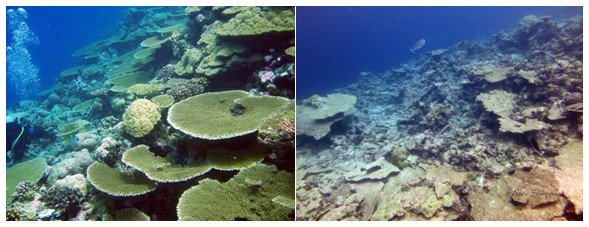
Warm-water coral reefs are facing unprecedented human-driven threats to their continued existence as biodiverse functional ecosystems upon which hundreds of millions of people rely. These impacts may drive coral ecosystems past critical thresholds, beyond which the system reorganises, often abruptly and potentially irreversibly; this is what the Intergovernmental Panel on Climate Change (IPCC, 2022) define as a tipping point. Determining tipping point thresholds for coral reef ecosystems requires a robust assessment of multiple stressors and their interactive effects.
Considering observed and projected stressor impacts, we endorse the global tipping point revision’s conclusion of a global mean surface temperature (relative to pre-industrial) tipping point threshold of 1.2 °C (range 1–1.5 °C) and the long-term impacts of atmospheric CO2 concentrations above 350 ppm, while acknowledging that comprehensive assessment of stressors, including ocean warming response dynamics, overshoot, and cascading impacts, have yet to be sufficiently realised.
These tipping point thresholds have already been exceeded, and therefore these systems are in an overshoot state and are reliant on policy actions to bring stressor levels back within tipping point limits. A fuller assessment of interacting stressors is likely to further lower the tipping point thresholds in most cases. Uncertainties around tipping points for such crucially important ecosystems underline the imperative of robust assessment and, in the case of knowledge gaps, employing a precautionary principle favouring lower-range tipping point values.
Previous assessments have highlighted the consequences of different levels of warming, as follows:
- 0.7 °C. “In the 1990s when global warming was around 0.7 °C large-scale coral reef bleaching also became apparent … supporting the lower boundary for this transition in respect of coral reefs” (IPCC, 2022).
- 1.0 °C. “Temperatures of just 1 °C above the long-term summer maximum … over 4–6 weeks are enough to cause mass coral bleaching … and mortality (very high confidence)” (Hoegh-Guldberg et al., 2018; Skirving et al., 2019).
- 1.2 °C. “Warm water (tropical) coral reefs are projected to reach a very high risk of impact at 1.2 °C …, with most available evidence suggesting that coral-dominated ecosystems will be non-existent at this temperature or higher (high confidence). At this point, coral abundance will be near zero at many locations and storms will contribute to `flattening’ the three-dimensional structure of reefs without recovery, as already observed for some coral reefs (Alvarez-Filip et al., 2009)” (Hoegh-Guldberg et al., 2018). Coral reef bleaching TPs (tipping points) have already been passed in seven ocean systems (IPCC, 2022; Lenton et al., 2023a).
- 1.5 °C. “Coral reefs… will undergo irreversible phase shifts due to marine heatwaves with global warming levels >1.5 °C and are at high risk this century even in <1.5 °C scenarios that include periods of temperature overshoot beyond 1.5 °C (high confidence)” (IPCC, 2022). Projections predict 70 %–90 % coral loss at 1.5 °C (Hoegh-Guldberg et al., 2018; IPBES, 2019; Souter et al., 2021; Armstrong-McKay et al., 2022), whereas finer-scale modelling projects a 95 %–98 % loss (Kalmus et al., 2022) and suggests a 99 % loss (Dixon et al., 2022).
- 2.0 °C. “[L]iterature since AR5 has provided a closer focus on the comparative levels of risk to coral reefs at 1.5 °C versus 2 °C of global warming … reaching 2 °C will increase the frequency of mass coral bleaching and mortality to a point at which it will result in the total loss of coral reefs from the world’s tropical and subtropical regions” (IPCC, 2018). Predictions show a 99 % coral loss at 2.0 °C (Frieler et al., 2013; Hoegh-Guldberg et al., 2018; IPBES, 2019; Knowlton et al., 2021; Souter et al., 2021; Armstrong-McKay et al., 2022; Wang et al., 2023). Finer-scale modelling projects a 100 % loss at 2.0 °C (Dixon et al., 2022; Kalmus et al., 2022).
Since the first global bleaching event of 1998, up to 71 % of the world’s reefs have experienced three further global mass bleaching events, with a fourth event being experienced in 2023–2024 1.
Assessments of risk to corals from heating typically do not consider co-occurring or interacting stressors or the delayed heating response to atmospheric greenhouse gas concentrations.
Veron et al. (2009) argue that to ensure the long-term viability of coral reefs, atmospheric CO2 levels must be reduced significantly below 350 ppm. Lenton et al. (2023a) recognise the long-term consequences of >350 ppm as a critical TP threshold, along with a global mean surface temperature (relative to pre-industrial) threshold of 1.2 °C (range 1–1.5 °C), while acknowledging that the “combined effects of long-term warming, sea level rise, ocean acidification, deoxygenation, and other stressors, bears more investigation”. The significance of both these TP thresholds is highlighted by the fact that global warming has already reached 1.2 °C, and CO2 levels have exceeded 420 ppm. Considering the calculations of von Schuckmann et al. (2020) that CO2 levels would need to be reduced to 353 ppm to realise the Paris temperature target, 350 ppm is likely to be insufficient for realising a 1.2 °C TP threshold, especially as other significant greenhouse gases are still increasing.
- https://www.noaa.gov/news-release/noaa-confirms-4th-global-coral-bleaching-event, last access: 17 January 2025[↩]